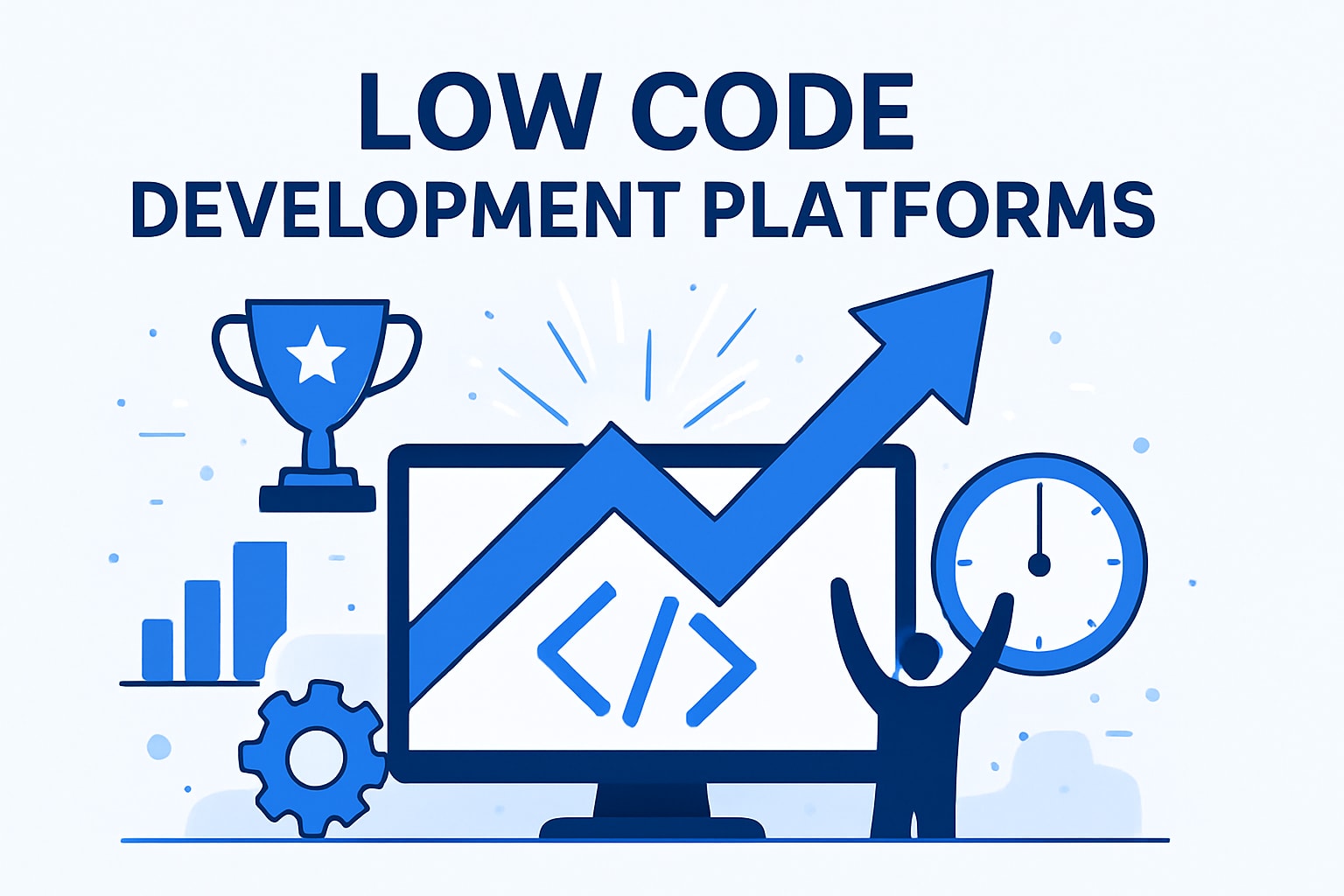Low code development platforms are transforming how businesses and individuals build software in 2025. As demand for faster, more cost-effective solutions grows, these platforms make app creation accessible to everyone, not just seasoned developers.
Curious about which tools stand out? In this guide, you’ll discover the 8 best low code development platforms to try in 2025, each with unique features and ideal use cases.
You’ll learn about platform highlights, pricing, pros and cons, and tips for choosing the right solution. Ready to accelerate your next project? Let’s dive in.
What is Low Code Development?
Low code development platforms are transforming how software is built in 2025. By empowering users to create applications visually, these tools eliminate much of the manual coding required by traditional development. If you're curious about how these platforms stack up, Low code development explained offers a helpful overview for beginners and experts alike.
Definition and Core Concepts
Low code development platforms use a visual, drag-and-drop approach to building software. Unlike traditional coding, where developers write extensive lines of code, low code platforms let users assemble applications from pre-built components and templates. This method reduces the need for deep technical expertise.
While no-code solutions focus on users with zero coding background, low code strikes a balance. It offers flexibility for non-developers and added customization for those with technical skills. The adoption of low code development platforms is accelerating across industries, supporting both web and mobile app creation.
With intuitive interfaces and reusable modules, these platforms make software development more accessible, faster, and less error-prone. Businesses of all sizes are leveraging this approach to drive digital transformation and keep up with evolving technology needs.
Benefits and Business Impact
The main advantage of low code development platforms is speed. Teams can launch apps in days instead of months, accelerating time-to-market and cutting development costs. This shift opens new possibilities for “citizen developers,” or business users with little technical background, to solve problems themselves.
According to Gartner, 70% of new applications will use low code or no-code tools by 2025. This statistic highlights the growing reliance on these platforms for agility and innovation. Companies from retail to finance are using low code development platforms to automate workflows, modernize legacy systems, and respond quickly to market changes.
Rapid prototyping and easy updates mean businesses can adapt faster than ever, delivering better results for customers and stakeholders.
Key Features of Modern Low Code Platforms
Today’s low code development platforms come packed with essential features:
- Drag-and-drop UI builders for fast interface design
- Workflow automation to streamline business processes
- Integration tools for connecting with databases, APIs, and third-party services
- Scalability, supporting everything from simple prototypes to enterprise-grade apps
- Strong security features to protect sensitive data
Many platforms also support multi-device deployment, letting you build apps for web, mobile, and even desktop from a single project. Advanced options include AI/ML integration and business process automation, making these platforms a smart choice for organizations aiming for efficiency and innovation.
Common Use Cases and Limitations
Popular use cases for low code development platforms include internal tools, CRM systems, workflow automation, data dashboards, and customer-facing applications. However, these platforms have limitations. Customization can be restricted compared to full-code development, and there’s a risk of vendor lock-in. Scalability may also be a challenge for very large enterprises with complex requirements.
Understanding these strengths and constraints is key to maximizing the value of low code development platforms for your business goals.
How to Choose the Right Low Code Platform in 2025
Selecting from the many low code development platforms can feel overwhelming, but making the right choice is crucial for your long-term success. The right platform will help your team build and deploy solutions quickly, securely, and within budget. Let’s break down the process so you can confidently match your needs to the best fit.
Critical Evaluation Criteria
When comparing low code development platforms, start by focusing on these essential factors:
- Ease of use: Is the interface intuitive for both technical and non-technical users?
- Integration capabilities: Can it connect to your existing tools and databases?
- Scalability: Will the platform support your growth, from pilot projects to enterprise-wide adoption?
- Support and community: Are resources, documentation, and active user communities available?
- Pricing: Does the model fit your budget and user base?
- Security and compliance: Does it offer enterprise-grade security and meet regulatory standards?
- Deployment options: Is it cloud-based, on-premise, or hybrid?
For a deeper dive into selection strategies, check out this guide on how to choose a no-code platform, which can also inform your approach for low code development platforms.
Matching Platform to Business Needs
Every organization has unique requirements, so align your chosen low code development platforms with your team’s skills, project scope, and goals.
For example, startups often prioritize rapid MVP launches and adaptability. They may seek platforms with easy onboarding and built-in templates. Enterprises, on the other hand, might need robust integration, advanced security, and scalability to support complex workflows.
Ask yourself:
- Do you need drag-and-drop simplicity, or advanced customization?
- Will your apps require frequent updates or handle sensitive data?
- Is your team technical, or do you want to empower non-developers?
Matching these needs ensures your investment delivers real value.
Cost Considerations and ROI
Low code development platforms offer various pricing models, such as:
- Per user: Pay by active users each month.
- Per app: Charges based on the number of applications built.
- Enterprise licenses: Custom pricing for larger organizations.
- Free tiers: Useful for testing or small teams.
Look beyond initial costs. Consider total cost of ownership, including hidden fees for integrations, premium features, or support. Calculate potential ROI by comparing development speed, reduced maintenance, and long-term scalability.
Future-Proofing Your Choice
The low code market is evolving fast. To future-proof your decision:
- Research vendor reputation and long-term vision.
- Engage with active communities for support and innovation.
- Review the platform’s roadmap for AI, automation, and new features.
- Choose solutions with strong automation and adaptability to keep pace with technology changes.
By staying proactive, you’ll ensure your platform remains a strategic asset for years to come.
8 Best Low Code Development Platforms to Try in 2025
The low code development platforms market is buzzing with innovation, offering a toolkit for everyone from startups to enterprises. With so many choices, how do you know which one is right for your next project? This curated list spotlights the 8 best low code development platforms to try in 2025, each with standout strengths, unique features, and clear target audiences. For a broader comparison, you can also explore the Top low code platforms in 2025.
Big House Technologies
Big House Technologies is a powerhouse among low code development platforms. Pricing is flexible, with Basic, Growth, and Enterprise plans tailored to different business needs. The platform’s core features include end-to-end no-code development, powerful AI integration, advanced UI/UX design, and tools for rapid MVPs and internal tool creation.
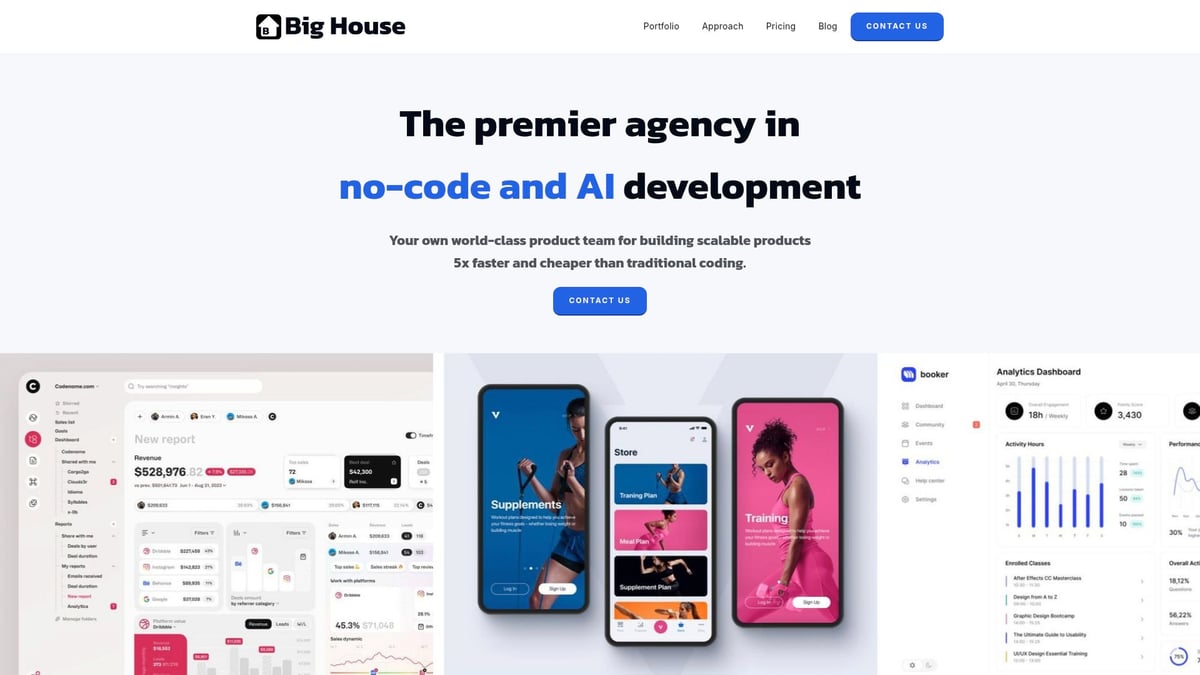
A key draw is the promise to build 5x faster and at a fraction of traditional software costs. Big House Technologies stands out for its deep project scoping, collaborative approach, and rigorous QA process. Its main audience includes startups, enterprises, business owners, and sectors like finance, agriculture, and oil and gas.
Pros:
- Exceptional speed and affordability
- Proven results (e.g., a client saved 2 million euros)
- Scalable for both small and large projects
- AI expertise
Cons:
- Focused primarily on Bubble and Lovable platforms
- May not cover every low code tool in the market
If you need an agile, AI-powered solution, this platform is a top contender among low code development platforms.
OutSystems
OutSystems ranks high among low code development platforms due to its enterprise-grade scalability and robust visual development environment. Pricing starts with a free tier for small teams and scales to custom-priced enterprise plans. The platform features visual development, AI-driven automation, cross-platform deployment, and built-in security.
Unique benefits include rapid prototyping, extensive integration capabilities, and a strong support community. OutSystems is ideal for enterprises, IT teams, and digital transformation leaders.
Pros:
- Handles complex, mission-critical applications
- Large, active user community
- Strong support
Cons:
- Steeper learning curve for advanced features
- Higher costs for enterprise-level deployments
OutSystems is trusted by major companies needing secure, scalable low code development platforms for digital transformation.
Zoho Creator
Zoho Creator is a user-friendly entry in the world of low code development platforms. Pricing starts at $10 per user per month, with a free trial available. Its core features include a drag-and-drop builder, multi-platform support, workflow automation, analytics, and a variety of integration options.
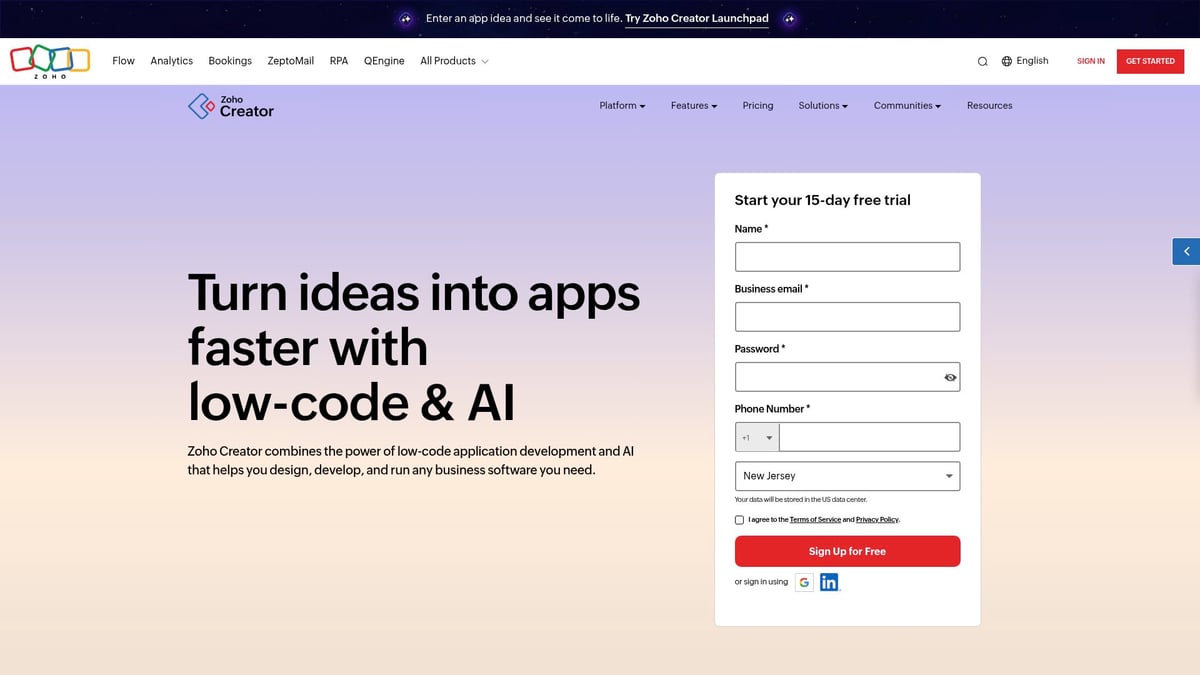
What sets Zoho Creator apart is its rapid app creation and customizable workflows, backed by over 7 million users worldwide. It’s perfect for SMEs, enterprises, and non-technical teams needing quick solutions.
Pros:
- Affordable and easy to learn
- Strong analytics and reporting
- Wide integration ecosystem
Cons:
- Limited advanced customization
- Some features restricted to higher pricing tiers
Zoho Creator was recognized in the Gartner Magic Quadrant for LCAP in 2020, highlighting its impact among low code development platforms.
GeneXus
GeneXus is a veteran among low code development platforms, offering AI-based code generation and support for multi-experience apps. Pricing is by developer seat, with special $100/month plans for startups and tailored options for ISVs and enterprises.

Its standout feature is tech-agnostic development, ensuring your apps are automatically updated to new technologies. GeneXus appeals to enterprises, ISVs, startups, and developers seeking a future-proof solution.
Pros:
- Supports multiple platforms and databases
- Strong automation and BPM features
- Adapts to evolving tech trends
Cons:
- Interface can feel outdated
- Pricing may be high for larger teams
With over 30 years in the market, GeneXus powers long-term, evolving systems for businesses relying on low code development platforms.
Visual LANSA
Visual LANSA delivers a hybrid low code IDE for desktop, web, and mobile app creation. Pricing starts at $16.66 per user per month, with mid-tier and enterprise options available. Its core features include a robust development environment, cross-platform deployment, and in-IDE code editing.
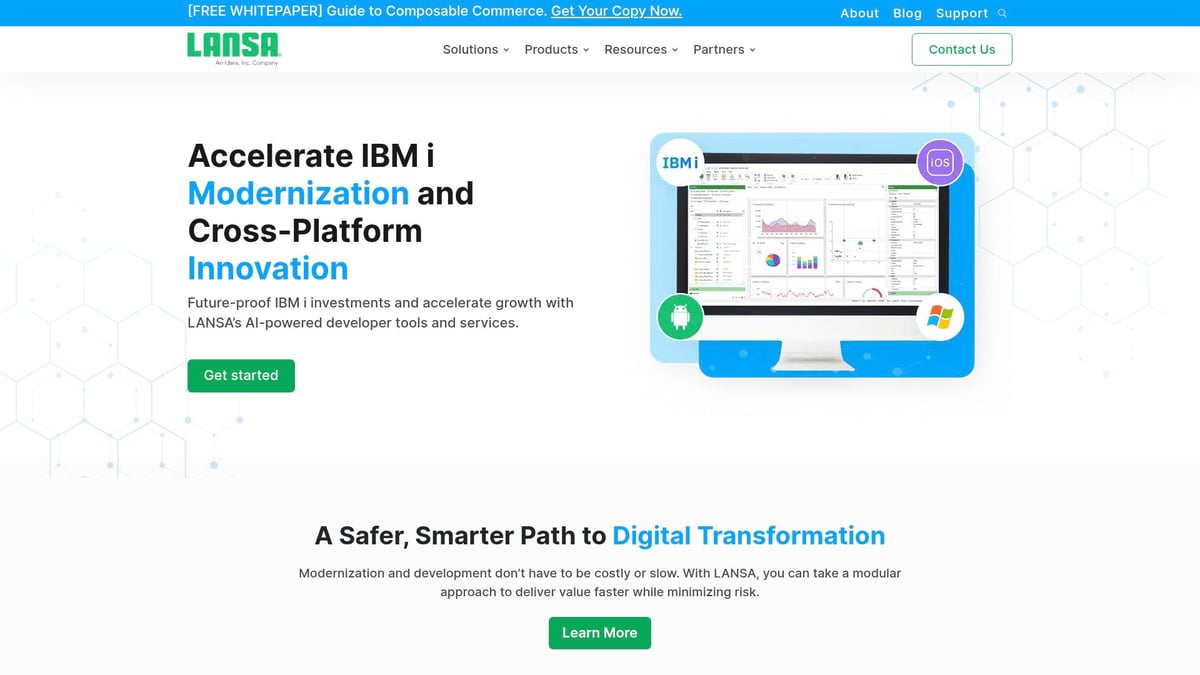
The platform is uniquely suited to companies running on IBMi, Windows, and web, offering deep customization for professional developers. Enterprises and IT departments with legacy systems find LANSA especially valuable.
Pros:
- Extensive deployment options
- High level of control and customization
- Strong integration capabilities
Cons:
- Less intuitive for non-developers
- May require technical onboarding
Thousands of organizations have modernized operations using Visual LANSA, making it a reliable choice among low code development platforms.
Creatio
Creatio blends no-code and low code development platforms into a seamless environment. Pricing starts at $25 per user per month, with a 14-day free trial. Its core features are workflow automation, composable architecture, AI/ML integration, and a vast library of templates.
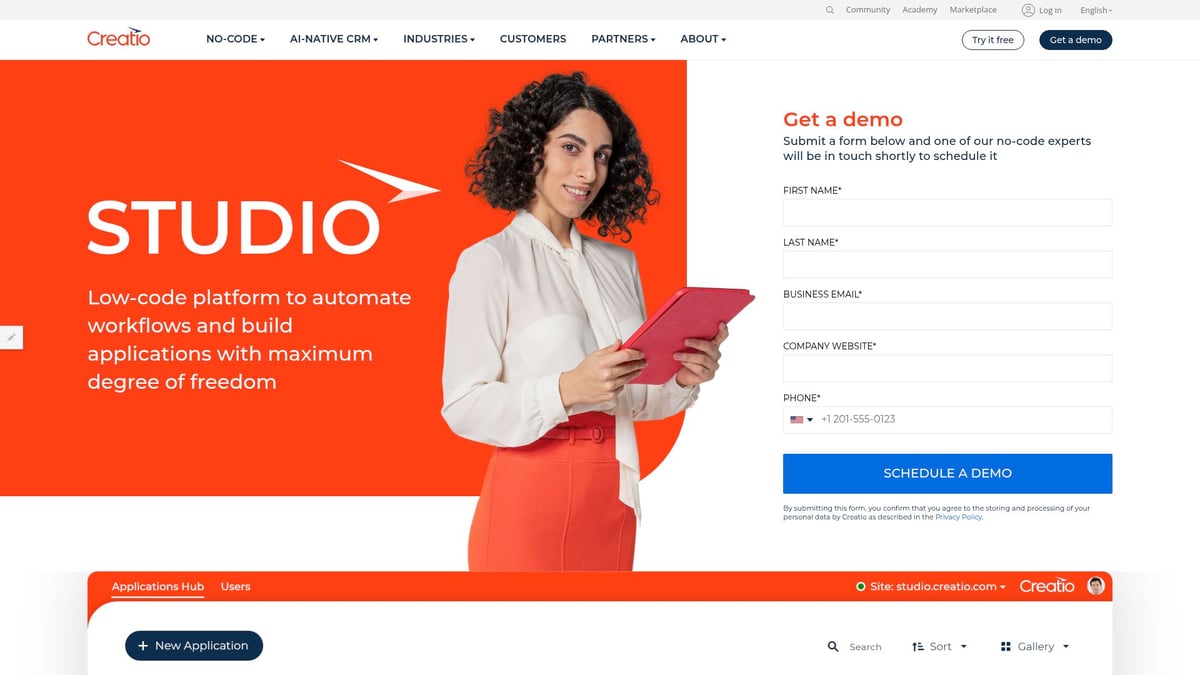
Creatio’s drag-and-drop tools enable business users to build apps within hours, supporting workflow and CRM automation. Its target audience includes businesses needing quick deployments and automation at scale.
Pros:
- User-friendly, intuitive interface
- Rapid app creation and deployment
- Extensive templates and connectors
Cons:
- Advanced features require higher pricing tiers
Creatio empowers users to accelerate innovation using low code development platforms without heavy technical demands.
UI Bakery
UI Bakery is a modern web app builder that focuses on internal tools. Pricing is free for development, with fixed plans for unlimited users. Core features include a visual builder, support for custom code, pre-built components, and connectors to various data sources.
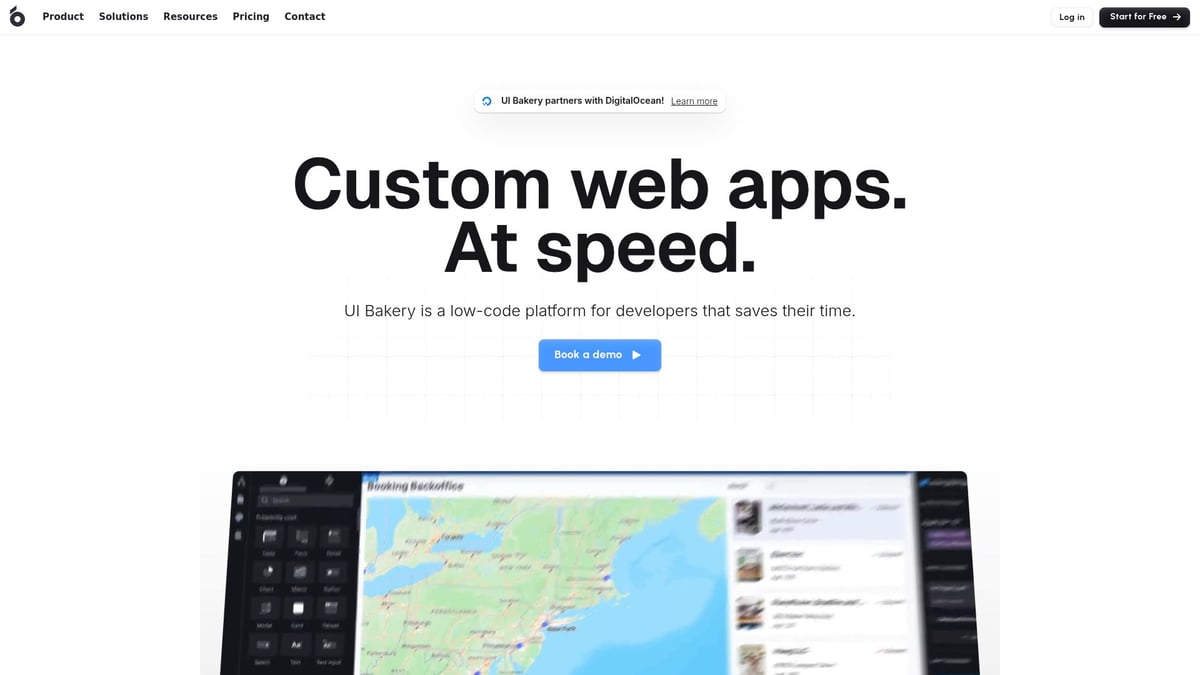
The platform’s unique selling points are unlimited users, flexible hosting (cloud or on-premise), and rapid CRUD app generation. UI Bakery is best for SMBs, internal tool builders, and teams needing quick, customizable solutions.
Pros:
- Fair, transparent pricing
- Flexibility with custom code
- Easy integrations
Cons:
- Focused on internal tools, not suited for public-facing complex apps
UI Bakery is trusted by SMEs looking to streamline operations with low code development platforms.
m-Power Development Platform
m-Power Development Platform stands out for its unlimited scalability and open architecture. Pricing is per database, with both perpetual and monthly license options, and no user or app fees. It combines low code development platforms with business intelligence, reporting, workflow automation, and full customization.
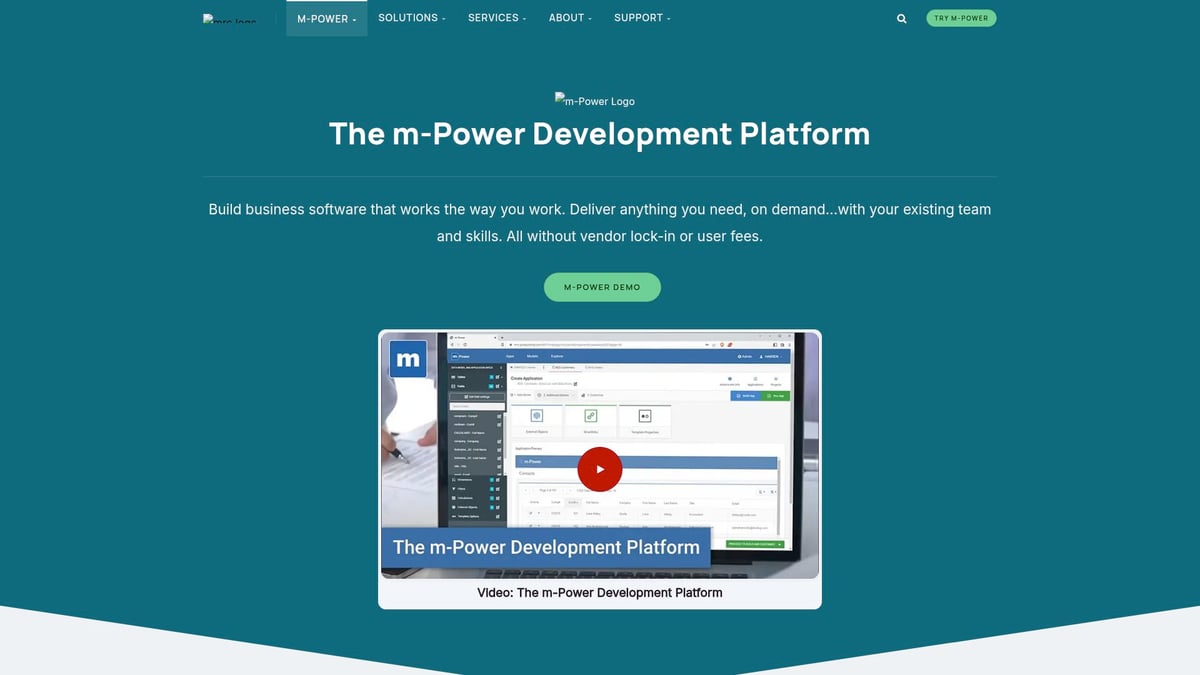
The platform is ideal for enterprises and organizations demanding adaptability, security, and no vendor lock-in. It is especially suited for building complex business applications.
Pros:
- No limits on users, apps, or features
- High versatility and security
- Open frameworks, avoiding vendor lock-in
Cons:
- May be overwhelming for small teams
- Requires some technical expertise
m-Power reduces development time by up to 80 percent, making it a robust solution among low code development platforms.
Comparing the Top 8 Low Code Platforms
Selecting the right low code development platforms can feel overwhelming with so many choices. To help you, we break down the most important details in a clear, side-by-side format. Use this overview to quickly spot which platform may fit your needs best.
Feature Comparison Table
Here’s a snapshot comparing the top low code development platforms. This table covers pricing, deployment, standout features, target users, and unique benefits.
| Platform | Pricing | Deployment | Key Features | Target Audience | Unique Benefit |
|---|---|---|---|---|---|
| Big House Technologies | Flexible plans | Cloud | AI, rapid MVP, QA | Startups, enterprises | 5x faster builds |
| OutSystems | Free, enterprise plans | Cloud, on-premise | Visual dev, security | Enterprises, IT | Enterprise scalability |
| Zoho Creator | From $10/user/month | Cloud, mobile | Drag-and-drop, analytics | SMEs, teams | Fast, affordable apps |
| GeneXus | By developer seat | Multi-platform | AI code, BPM | Enterprises, ISVs | Tech-agnostic updates |
| Visual LANSA | From $8.34/user/month | Desktop, web, mobile | IDE, deep customization | IT, legacy systems | Integration flexibility |
| Creatio | From $25/user/month | Cloud | No-code, workflow, AI | Workflow, CRM teams | Composable automation |
| UI Bakery | Free, fixed plans | Cloud, on-premise | Web builder, data connectors | SMBs, internal tools | Unlimited users |
| m-Power | Per database, unlimited | Cloud, on-premise | BI, reporting, open architecture | Enterprises | No vendor lock in |
With this table, you can quickly compare low code development platforms and identify which ones align with your goals.
Strengths and Weaknesses Analysis
Each of the top low code development platforms comes with unique strengths and trade offs. For instance, Big House Technologies excels in rapid delivery and AI, making it ideal for startups and specific industries. OutSystems and GeneXus are praised for enterprise scale and robust integration, though they may have steeper learning curves.
Platforms like Zoho Creator and UI Bakery shine with user friendliness and affordability but may have feature limitations for complex needs. m-Power stands out for unlimited scalability and customization, which can be overwhelming for small teams.
To make an informed choice, review expert evaluations such as the Gartner Magic Quadrant for Enterprise Low-Code Application Platforms 2022, which analyzes strengths, weaknesses, and best use cases for leading platforms.
Real-World Application Scenarios
Businesses across industries are achieving real impact with low code development platforms. A startup may use Big House Technologies to launch an MVP in weeks, saving substantial costs and time. Enterprises often turn to OutSystems or Visual LANSA to modernize legacy systems and streamline workflows.
Small and medium businesses leverage Zoho Creator or UI Bakery to automate internal processes, create dashboards, or build simple customer portals. Large organizations seeking data heavy apps or unlimited users frequently choose m-Power for its open architecture and scalability.
These scenarios show how low code development platforms empower teams to solve challenges quickly and flexibly, without deep coding expertise.
Trends and Predictions for 2025
The future of low code development platforms looks brighter than ever. Analysts predict a surge in AI and machine learning features, making platforms smarter and more adaptive. Composable architectures and workflow automation are becoming the norm, enabling faster, more modular app creation.
Non technical users, or “citizen developers,” are expected to drive even more adoption. According to Gartner, by 2025, a significant majority of new applications will be built using low code approaches. This trend means businesses of all sizes are poised to benefit from faster innovation and reduced development bottlenecks.
Low code development platforms are set to transform how organizations tackle digital transformation in the years ahead.
Maximizing Success with Low Code Adoption
Adopting low code development platforms can transform how your organization builds software, but success depends on more than just picking a tool. To realize the full potential, it’s important to approach adoption strategically, avoid common traps, and foster a culture that encourages innovation at every level.
Implementation Best Practices
Getting started with low code development platforms requires a plan. Begin by securing buy-in from all stakeholders, including business leaders and IT teams. This ensures alignment on goals and expectations. Next, run a pilot project with clear objectives to demonstrate value and gather feedback.
Invest in training for both technical and non-technical users so everyone can leverage the platform’s features. Establish governance by setting guidelines for app creation, data management, and security. With the Gartner forecasts 70% of new applications will use low-code/no-code by 2025, it’s clear that strong adoption strategies are essential for staying competitive. Finally, ensure IT and business teams collaborate closely throughout the process.
Avoiding Common Pitfalls
Even with the right low code development platforms, mistakes can derail your progress. One common pitfall is underestimating the need for customization. Not all business needs fit out-of-the-box solutions, so assess customization options early.
Another risk is overlooking security and compliance requirements, which can lead to vulnerabilities. Don’t forget to plan for long-term scalability and maintenance, as initial rapid results may hide future challenges. To avoid these issues, document requirements, involve security experts, and choose platforms with proven track records.
Ensuring Scalability and Security
As your solutions grow, scaling low code development platforms across teams and departments becomes crucial. Choose platforms that support high user volumes, integration with existing systems, and multi-device deployment.
Prioritize security by selecting tools with strong access controls, data encryption, and compliance certifications. Regularly review permissions and audit app usage to maintain oversight. By building on secure, scalable foundations, organizations can confidently expand their digital solutions without sacrificing safety or performance.
Building a Culture of Innovation
Low code development platforms thrive in environments where experimentation and learning are encouraged. Foster a “citizen developer” mindset by empowering employees at all skill levels to build and iterate on apps.
Offer workshops, recognition programs, and internal showcases to highlight successful projects. When teams see the impact of their work, enthusiasm grows and adoption spreads organically. Organizations that nurture this culture often discover new ideas and process improvements that drive ongoing digital transformation.
Frequently Asked Questions About Low Code Platforms
Curious about low code development platforms? Here are answers to the most common questions, helping you make informed decisions as you explore these powerful tools.
What distinguishes low code from no-code platforms?
Low code development platforms offer a balance between flexibility and simplicity. They use visual tools and pre-built modules, but also allow some manual coding for advanced features. No-code platforms, in contrast, require no programming at all, focusing on drag-and-drop simplicity for basic solutions. If you want to dive deeper, check out this detailed Low code vs no code differences guide for a full comparison of customization, target users, and technical requirements.
Can low code platforms handle enterprise-scale applications?
Yes, many low code development platforms are designed for enterprise needs. They support high scalability, robust integrations, and advanced security to power mission-critical systems. Large companies use these platforms for complex workflows, automations, and customer-facing solutions. Always assess platform capabilities against your business requirements for best results.
How secure are low code solutions?
Security is a top priority for leading low code development platforms. Most offer built-in features like role-based access, data encryption, audit trails, and compliance certifications (such as GDPR or SOC 2). It is important to review each platform’s security documentation and configure settings to match your organization’s standards.
What’s the learning curve for non-technical users?
Most modern low code development platforms are built for accessibility. Non-technical users benefit from visual interfaces, guided tutorials, and extensive support resources. Many platforms offer onboarding programs, video guides, and active user communities to ease the learning process.
How do pricing models typically work?
Pricing for low code development platforms varies. Common models include per-user fees, per-app licensing, and enterprise packages. Some platforms offer free tiers or trials, while enterprise versions may require custom quotes. Always consider total cost of ownership, including potential add-ons and support.
Are there risks of vendor lock-in?
Vendor lock-in can be a concern with some low code development platforms. To minimize this risk, look for platforms that support open standards, offer export options, and provide clear migration paths. Review contract terms and ask about data portability before committing to a solution.
Now that you’ve explored the top low code platforms to watch in 2025, you might be thinking about how quickly you could bring your own ideas to life. The beauty of low code is that it’s all about speed and turning possibilities into real solutions—without the long waits or huge budgets. If you’re ready to move fast and get your MVP out to market while these trends are hot, I’ve got a resource you’ll love. Check out how you can Launch Your MVP in Weeks, Not Months and see what’s truly possible for your next project.




About Big House
Big House is committed to 1) developing robust internal tools for enterprises, and 2) crafting minimum viable products (MVPs) that help startups and entrepreneurs bring their visions to life.
If you'd like to explore how we can build technology for you, get in touch. We'd be excited to discuss what you have in mind.
Other Articles
Discover the top 7 best AI apps for iPhone in 2025 that boost productivity, creativity, and convenience Choose the right AI tools to transform your daily workflow
Discover the future of QA software development in 2025. Explore trends, tools, AI, best practices, and step-by-step strategies to ensure software excellence.
Explore the key differences between Freemium, Free-Trial, and Hybrid pricing models for SaaS. Learn how each strategy impacts user acquisition, retention, and conversions to optimize growth and revenue.

